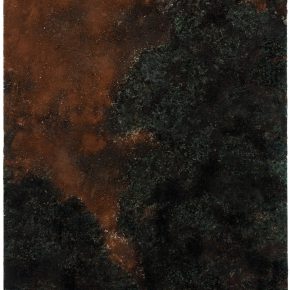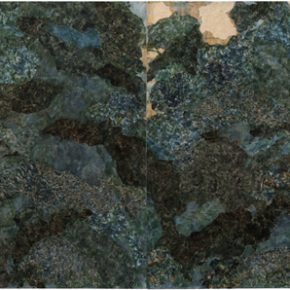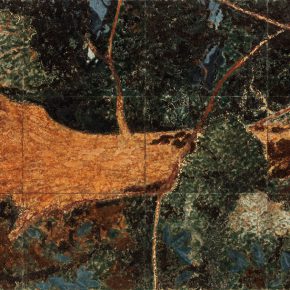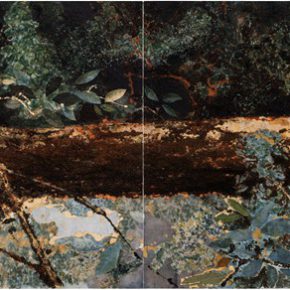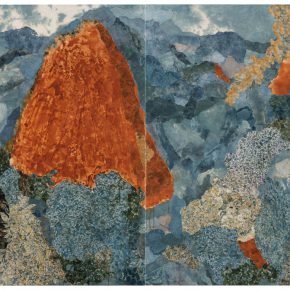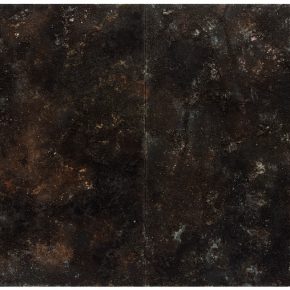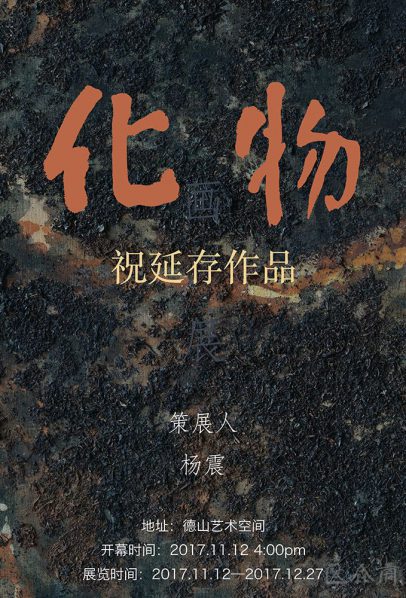
By Yang Zhen
Where would Chinese contemporary art go: could art still find its own direction under the coercion of two alienating strength of capital and power? In the post-art and post-historical contexts of “the death of author”?and “the end of art”, how could artists still guarantee the necessity of their existence and the originality of their art? After the group of contemporary Chinese artists have conducted excessive exploitation of traditional cultural symbols and modern commercial and political signs, how could they continue to exert their own “Chinese nature”?and “contemporary features”?as well as the “international character”?based on the above two? With his many years of silent and persistent efforts, Zhu Yancun has responded to the above three challenges, and made progress with his own answer:
I. From Humanism to Life Concerns
The enchantment of Zhu Yancun’s painting with natural materials, does not lie in the material itself, but with the reason that he never creates for the material’s sake, as he did not seek them with materials, instead he naturally finds the language tailored for himself with his consistent temperament of philosopher, sensitivity of artist and continuous humanism, thus he creates this kind of language with a strong vitality.
II. From Bystander to Presence
There is a kind of undemonstrative “contemporary feature”?in Zhu Yancun’s work, the key lies in their temporal feature: forms are no longer eternal, and colors are allowed to ferment, they belong to a folding process, and meanwhile they are open to a changing continuation; they are not the perfect tense, but the continuous tense; from intra-field to outer-field, communicating between art and non-art, thus endowing more things with artistic nature while restoring more original vitality to art, so that they are the arts of intervention rather than those of separation. They are arts of participation rather than onlookers. Such a participation does not belong to wavers of flags and people vocal with slogans but the absorption and infiltration of?the?inner spirit, which is a profound display of how art as the flower of life exchanges energy with the soil of entire life and proceeds with?this physical circulation.
III From Passion to Meditation
These paintings Zhu Yancun has created in recent years, have shown an introverted low-profile tone with plain and realistic composition, a concise relationship. The general appearance of his paintings sometimes seems to be bright and clean, sometimes to be calm; when observing them one feels the inner peace with even breathing, as they have the effect of inner meditation. Although none of the Chinese elements have been shown off, his works imply that the spirit of Chinese Taoism and Zen have continuously developed. He painted “The Spring of Jingxi”, which is not an over-arching one, but it conveys a silent flow of life; his series of “Dapingzhang”, “Looking for the Ancestor of Tea”, “Wengji”?series, “Jingmai Mountain”?series, they are not portrayals of any specific objects, but a profound and far-reaching visual representation of geography and humanity.
Therefore, we entitled this exhibition as “Spiritual Transformation”, from “Social Commitment” which was the title of the last solo exhibition to “Spiritual Transformation” which is the theme this solo exhibition, and this is the brief summary of the above three forms of evolution. As the famous tale of “Chuang Chou Dreaming a Butterfly” says, “it could not be told whether Chuang Chou transformed into a butterfly in his dream or a butterfly transformed into Chuang Chou in its dream? There must be a difference between Chuang Chou and butterfly, which means the Oneness with all beings.” Sometimes we could not help asking: whether Yancun paints (transforms) plants, or these plants paint (transform) Yancun? –?there must be a difference between Yancun and plants. This is so-called art.
Preface by the AuthorJacques Barzun once said: “In art, the strength and quality of the effect is entirely up to reason”.
This reason might be the issue concerning how artists think and care about the depth and sense of propriety from the social perspective, or it might be the issue related to self-cultivation.
As long as I was born and I am living in such a materialistic world, I am frustrated so I struggle to find the answer to the solution of human existence.
From “Sketches on the Pamirs”?in 2000 to “Waiting”?in 2006, as to the later “Essence”?series and so on, all of them belong to the practical process in exploring this theme and they differ in process that I gradually seek from the unconscious state to a conscious one, and look from the outside to the inside. Thus, I experiment with the corresponding linguistic approach in constant introspection and meditation.
While being retrospective and pondering on history, I experience the incomprehensibility of the “truth”?and the dynamics of time. The poetic sentiment of history, if under the index of geographically natural saturation, generates specific experiences of history, nature and human “being”, including the events that occur, or would affect the future direction of individuals, are likely to be transformed into elements in my image.
Every painted “scene”?becomes the “Bodhimanda”?where I watch and experience, materials are both the objects to be watched, and “paints”?mixed with emotions, which realizes the transformation of information.
This exhibition showcases my newest work since my last exhibition “Social Commitment”?in Singapore.
My creative theme is based on the landscape of Jingmai Mountain where I conducted?my exploration and expression on life experience, as well as the existence of subject and object in images, which could also be taken as a philosophical response to the theme of creation on Tahiti proposed by Gauguin, “Who are we? Where are we from? Where are we going?”
The individualist aspect or unique quality of image has always been the object I pursue, but I am suffering from falling short of my wishes in finding a future direction. After I gradually solved some material barriers, I received comfort and relief in my heart! Naturally, the image therefore generated also partially materializes the visual message I would like to convey! This information is also my attitude towards life, as Tagore said, “There are no traces of wings in the sky, but I have flown over.”
Someone asked me, why do you paint with natural material on a scene? My simple answer is: they?are there! It?can also be said that it is because of the mutual existence relationship between natural things and me, or even my extreme identification with the ancestor’s wisdom of All Is One!
No matter how I interpret?it, it seems to be faint, but seeking an unique expression and exact statement which should be traced to the mental field I have been endowed with. Therefore I dare not bluff my way to conceal my shortcoming, but only to follow my heart, and make up for the lack of my character with my endeavors. Exactly as my good friend Zhang Hui often talked with me that: doing art is like doing long-distance running, which relies on the will and endurance!
The endurance I understand should have continuous improvement in one’s mental qualities as a prerequisite, so that it is possible for one to keep going on a?“l(fā)ong-distance race”!
Since I like painting, I will keep painting!
So life and art will go on!
Arthur Danto once commented on: “The End of Art!”?There’s a voice echoing in my heart “Yet I have not painted enough, how could it have ended?!
Zhu Yancun
November 15, 2017
About the exhibition
Dates: November 12th – December 27th, 2017
Venue: Deshan Art Gallery
Courtesy of the artist and Deshan Art Gallery.



